全胸腔镜肺叶切除术应用于临床早期肺癌的临床价值分析
- 格式:pdf
- 大小:184.22 KB
- 文档页数:2

全胸腔镜下与开胸肺叶切除术治疗早期肺癌疗效对比观察引言:肺癌是世界上最常见的恶性肿瘤之一,也是导致癌症相关死亡的主要原因之一。
早期肺癌的治疗是关键,以提高患者的存活率和生活质量。
全胸腔镜下与开胸肺叶切除术是常用的治疗早期肺癌的两种方法。
本文对这两种方法在疗效方面进行对比观察。
全副腔镜下肺叶切除术的优点:全腔镜下肺叶切除术是近年来发展起来的一种微创手术方法,相较于传统的开胸手术,具有诸多优势。
首先,全腔镜手术具有较小的创伤,患者术后疼痛轻、出血少、康复快。
其次,由于手术视野清晰,操作精细,具有较高的精确性,能够更好地保护周围的正常组织。
此外,全腔镜手术可减少手术时间,降低术中并发症的风险。
开胸肺叶切除术的优势与限制:与全腔镜术相比,开胸手术在一些方面有其自身的优势。
首先,开胸手术具有更好的触觉和立体视觉,能够更准确地判断肺叶切除的范围,提高手术的安全性。
其次,开胸手术在处理肿瘤部分时有更大的灵活性,便于处理更复杂的情况。
然而,开胸手术存在较大的创伤,患者术后疼痛较重,需要较长的康复期。
疗效对比观察:一项研究对全腔镜和开胸手术治疗早期肺癌的疗效进行了观察。
研究发现,两种手术方法在肿瘤切除率方面无显著差异,而全腔镜手术相较于开胸手术在切口长度、术中出血量和术后并发症的发生率方面均优于开胸手术。
此外,术后住院时间也较开胸手术明显缩短。
综合来看,全腔镜手术在治疗早期肺癌方面具有更加明显的优势。
结论:综上所述,全腔镜下与开胸肺叶切除术是治疗早期肺癌的两种常用手术方法。
全腔镜手术相较于开胸手术具有诸多优势,如创伤小、恢复快、并发症少等。
虽然开胸手术在触觉和操作的灵活性方面优越,但其术后疼痛和康复期较长。
在疗效方面,全腔镜手术也表现出明显的优势。
因此,对于早期肺癌患者,全腔镜手术是一种更为适宜的治疗选择。
然而,需要指出的是,虽然全腔镜手术具有多方面的优势,但实施该手术需要较高的技术水平和经验丰富的医生。
此外,不同患者的具体情况也会影响手术的选择,包括肿瘤位置、患者的年龄和健康状况等。
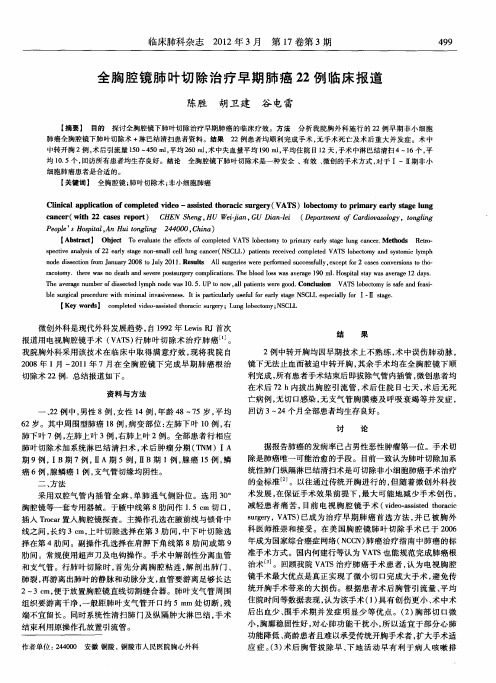
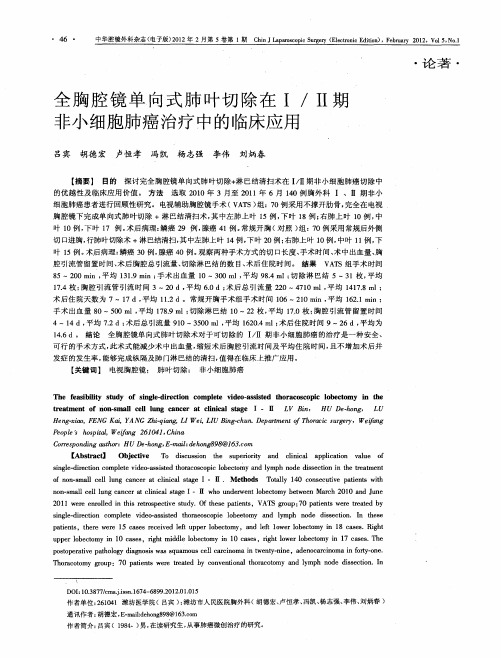
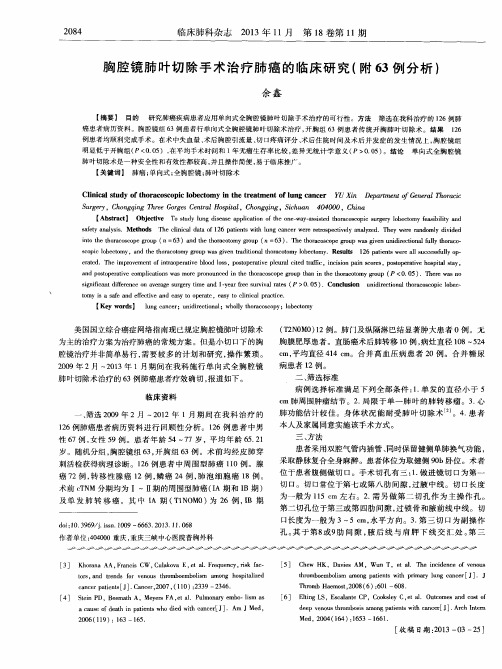
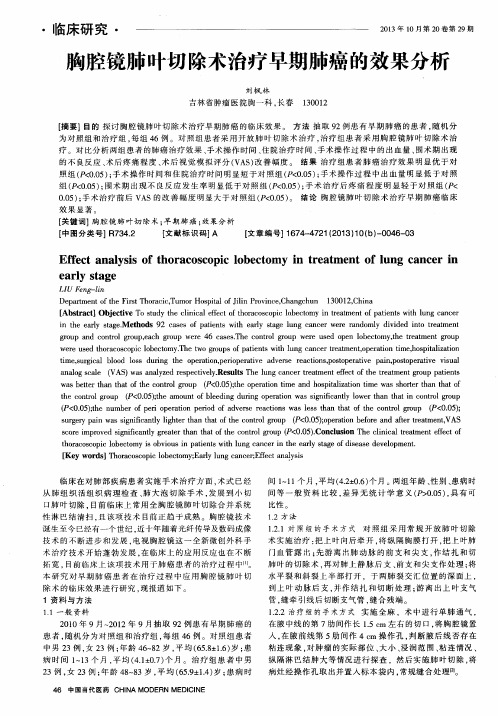
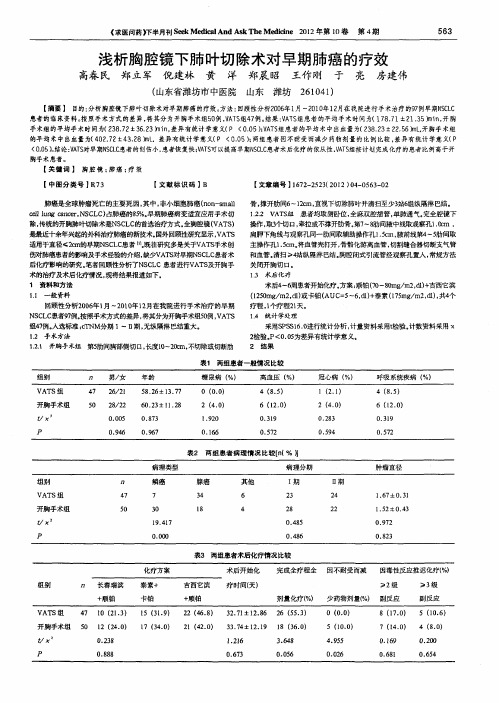
- 137 -①福建医科大学附属第二医院 福建 泉州 362000通信作者:杨建胜胸腔镜下肺亚段切除术治疗早期肺癌患者的临床效果吴佳云① 杨建胜① 林良安① 江文坛①【摘要】 目的:探讨胸腔镜下肺亚段切除术治疗早期肺癌患者的临床效果。
方法:回顾性分析2022年3月—2023年3月福建医科大学附属第二医院收治的94例早期肺癌患者的临床资料。
根据不同手术方式将其分为对照组(n =45)和观察组(n =49)。
观察组给予胸腔镜下肺亚段切除术,对照组给予胸腔镜下肺段切除术。
比较两组围手术期指标,术前和术后1 d、3 d 炎症因子及并发症。
结果:两组手术时间、术中出血量、病灶切缘宽度、住院时间比较,差异无统计学意义(P >0.05),观察组切除亚段数少于对照组,差异有统计学意义(P <0.05)。
术后1 d、3 d,两组C 反应蛋白(CRP)、降钙素原(PCT)水平均高于术前,术后3 d,两组CRP、PCT 水平低于术后1 d,观察组CRP、PCT 水平均低于对照组,差异有统计学意义(P <0.05)。
两组并发症发生率比较,差异无统计学意义(P >0.05)。
结论:胸腔镜下肺段切除术与胸腔镜下肺亚段切除术治疗早期肺癌手术效果相当,但胸腔镜下肺亚段切除术可减少切除亚段数目,减轻术后短期内炎症反应。
【关键词】 肺癌 胸腔镜 肺亚段切除术 doi:10.14033/ki.cfmr.2023.29.035 文献标识码 B 文章编号 1674-6805(2023)29-0137-04 Clinical Effect of Pulmonary Subsegment Resection under Thoracoscopy in the Treatment of Patients with Early Lung Cancer/WU Jiayun, YANG Jiansheng, LIN Liang ’an, JIANG Wentan. //Chinese and Foreign Medical Research, 2023, 21(29): 137-140 [Abstract] Objective: To explore the clinical effect of pulmonary subsegment resection under thoracoscopy in the treatment of patients with early lung cancer. Method: The clinical data of 94 patients with early lung cancer admitted to the Second Affiliated Hospital of Fujian Medical University from March 2022 to March 2023 were retrospectively analyzed. They were divided into control group (n =45) and observation group (n =49) according to different surgical methods. The observation group received pulmonary subsegment resection under thoracoscopy, and the control group received pulmonary segment resection under thoracoscopy. Perioperative indexes, inflammatory factors before and 1 d, 3 d after surgery and complications were compared between the two groups. Result: There were no significant differences in surgery time, intraoperative blood loss volume, lesion incisal margin width, and hospital stay between the two groups (P >0.05). The number of resection subsegments in the observation group was less than that in the control group, and the difference was statistically significant (P <0.05). At 1 d and 3 d after surgery, the levels of C-reactive protein (CRP) and procalcitonin (PCT) in the two groups were higher than those before surgery, 3 d after surgery, CRP and PCT levels in both groups were lower than 1 d after surgery, and the levels of CRP and PCT in observation group were lower than those in control group, and the differences were statistically significant (P <0.05). There was no significant difference in the incidence of complications between the two groups (P >0.05). Conclusion: The surgery effect of pulmonary segmental resection under thoracoscopy and pulmonary subsegment resection under thoracoscopy is equivalent in the treatment of early lung cancer. However, pulmonary subsegment resection under thoracoscopy can reduce the number of resected subsegments and alleviate short-term inflammatory reactions after surgery. [Key words] Lung cancer Thoracoscopy Pulmonary subsegment resection First-author's address: The Second Affiliated Hospital of Fujian Medical University, Quanzhou 362000, China 肺癌是一种临床较为常见的癌症,在所有癌症中,其致死率最高[1-2]。